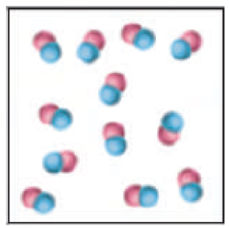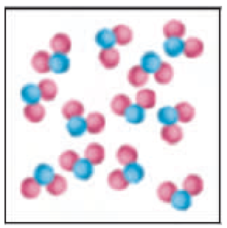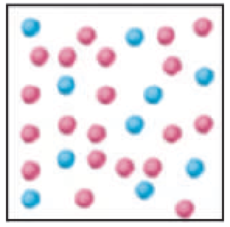
Bundle: Chemistry: The Molecular Science, 5th, Loose-Leaf + OWLv2 with Quick Prep 24-Months Printed Access Card
5th Edition
ISBN: 9781305367487
Author: John W. Moore, Conrad L. Stanitski
Publisher: Cengage Learning
expand_more
expand_more
format_list_bulleted
Concept explainers
Textbook Question
Chapter 3, Problem 32QRT
Which drawing is the best nanoscale representation of an aqueous solution of magnesium nitrate? (Water molecules are not shown for simplicity.)




Expert Solution & Answer
Want to see the full answer?
Check out a sample textbook solution
Students have asked these similar questions
Hi can you please help me solve these problems? thank you
Hi can you please help me solve this problem? thank you
Hi can you please help me solve this problem? thank you
Chapter 3 Solutions
Bundle: Chemistry: The Molecular Science, 5th, Loose-Leaf + OWLv2 with Quick Prep 24-Months Printed Access Card
Ch. 3.1 - When washing soda, Na2CO3, reacts with sulfuric...Ch. 3.2 - When sprayed into the flame of a torch, powdered...Ch. 3.2 - Prob. 3.1PSPCh. 3.2 - Prob. 3.2PSPCh. 3.3 - Prob. 3.3PSPCh. 3.3 - Prob. 3.4PSPCh. 3.3 - Prob. 3.5PSPCh. 3.3 - Prob. 3.6PSPCh. 3.3 - Prob. 3.3CECh. 3.4 - Phosphoric acid, H3PO4, has three protons that can...
Ch. 3.4 - Prob. 3.5CECh. 3.4 - Look back through the discussion of electrolytes...Ch. 3.4 - Prob. 3.8PSPCh. 3.4 - Prob. 3.9PSPCh. 3.4 - Write a balanced equation for the reaction of...Ch. 3.4 - Prob. 3.6ECh. 3.4 - Prob. 3.7ECh. 3.4 - Prob. 3.8ECh. 3.4 - Prob. 3.9CECh. 3.4 - Prob. 3.10CECh. 3.5 - Prob. 3.11CECh. 3.5 - Prob. 3.12CECh. 3.5 - Prob. 3.13ECh. 3.5 - Prob. 3.11PSPCh. 3.5 - Prob. 3.12PSPCh. 3.5 - Prob. 3.14CECh. 3.6 - Prob. 3.15CECh. 3.6 - Prob. 3.16ECh. 3.6 - Prob. 3.13PSPCh. 3.6 - Prob. 3.17ECh. 3.6 - Prob. 3.14PSPCh. 3.7 - Prob. 3.15PSPCh. 3.7 - Using the same reaction, calculate the mass of...Ch. 3.7 - At high temperatures, silicon dioxide reacts with...Ch. 3.7 - Urea is used as a fertilizer because it can react...Ch. 3.8 - Assume the methanol synthesis has an 85.0% yield...Ch. 3.8 - Prob. 3.19PSPCh. 3.8 - Prob. 3.19ECh. 3.8 - Prob. 3.20ECh. 3.9 - Phenol is a compound of carbon, hydrogen, and...Ch. 3.9 - Calcium carbonate forms carbon dioxide and calcium...Ch. 3.10 - Prob. 3.20PSPCh. 3.10 - Prob. 3.23ECh. 3.10 - Prob. 3.24ECh. 3.10 - Prob. 3.25CECh. 3.10 - Describe how you would prepare each solution.
1.00...Ch. 3.10 - Prob. 3.26ECh. 3.10 - Prob. 3.22PSPCh. 3.10 - Prob. 3.27CECh. 3.11 - Prob. 3.23PSPCh. 3.11 - Prob. 3.24PSPCh. 3.11 - Sodium chloride is used in intravenous solutions...Ch. 3.12 - Show that the reaction of KMnO4 with H2O2 is a...Ch. 3.12 - Prob. 3.25PSPCh. 3 - Aqueous solutions of ammonium sulfide and...Ch. 3 - In a blast furnace at high temperature, iron(III)...Ch. 3 - What information does a balanced chemical equation...Ch. 3 - Prob. 2QRTCh. 3 - Prob. 3QRTCh. 3 - Prob. 4QRTCh. 3 - Prob. 5QRTCh. 3 - Prob. 6QRTCh. 3 - When asked, “What is the limiting reactant?” you...Ch. 3 - Prob. 8QRTCh. 3 - Prob. 9QRTCh. 3 - For this reaction, fill in the table with the...Ch. 3 - Prob. 11QRTCh. 3 - Prob. 12QRTCh. 3 - This diagram shows A (blue spheres) reacting with...Ch. 3 - Prob. 14QRTCh. 3 - Prob. 15QRTCh. 3 - Prob. 16QRTCh. 3 - Prob. 17QRTCh. 3 - Prob. 18QRTCh. 3 - Prob. 19QRTCh. 3 - Balance these equations. (a) UO2(s) + HF() UF4(s)...Ch. 3 - Prob. 21QRTCh. 3 - Prob. 22QRTCh. 3 - Prob. 23QRTCh. 3 - Balance these combustion reactions. (a) C6H12O6 +...Ch. 3 - Prob. 25QRTCh. 3 - Prob. 26QRTCh. 3 - Prob. 27QRTCh. 3 - Which substance conducts electricity when...Ch. 3 - Prob. 29QRTCh. 3 - Predict whether each compound is soluble in water....Ch. 3 - Prob. 31QRTCh. 3 - Which drawing is the best nanoscale representation...Ch. 3 - If aqueous solutions of potassium carbonate and...Ch. 3 - If aqueous solutions of potassium sulfide and...Ch. 3 - Prob. 35QRTCh. 3 - Prob. 36QRTCh. 3 - Prob. 37QRTCh. 3 - Prob. 38QRTCh. 3 - Prob. 39QRTCh. 3 - Prob. 40QRTCh. 3 - Prob. 41QRTCh. 3 - Prob. 42QRTCh. 3 - Prob. 43QRTCh. 3 - Prob. 44QRTCh. 3 - Prob. 45QRTCh. 3 - Prob. 46QRTCh. 3 - Prob. 47QRTCh. 3 - Prob. 48QRTCh. 3 - Prob. 49QRTCh. 3 - Prob. 50QRTCh. 3 - Prob. 51QRTCh. 3 - Prob. 52QRTCh. 3 - Prob. 53QRTCh. 3 - Prob. 54QRTCh. 3 - Prob. 55QRTCh. 3 - Prob. 56QRTCh. 3 - Prob. 57QRTCh. 3 - Prob. 58QRTCh. 3 - Nitrogen monoxide is oxidized in air to give brown...Ch. 3 - Prob. 60QRTCh. 3 - The final step in the manufacture of platinum...Ch. 3 - Disulfur dichloride, S2Cl2, is used to vulcanize...Ch. 3 - Prob. 63QRTCh. 3 - Prob. 64QRTCh. 3 - Prob. 65QRTCh. 3 - Prob. 66QRTCh. 3 - Prob. 67QRTCh. 3 - Cisplatin, Pt(NH3)2Cl2, a drug used in the...Ch. 3 - Aluminum chloride, Al2Cl6, is an inexpensive...Ch. 3 - Prob. 70QRTCh. 3 - Prob. 71QRTCh. 3 - Prob. 72QRTCh. 3 - Prob. 73QRTCh. 3 - Quicklime, CaO, is formed when calcium hydroxide...Ch. 3 - Prob. 75QRTCh. 3 - Disulfur dichloride, which has a revolting smell,...Ch. 3 - Prob. 77QRTCh. 3 - Prob. 78QRTCh. 3 - Quinone, which is used in the dye industry and in...Ch. 3 - l-Dopa is a drug used for the treatment of...Ch. 3 - Write the balanced chemical equation for the...Ch. 3 - Prob. 82QRTCh. 3 - Prob. 83QRTCh. 3 - Prob. 84QRTCh. 3 - Prob. 85QRTCh. 3 - Prob. 86QRTCh. 3 - You need 300. mL of 0.500-M K2Cr2O7. Which method...Ch. 3 - You need to make a 0.300-M solution of NiSO4(aq)....Ch. 3 - You wish to make a 0.200-M solution of CuSO4(aq)....Ch. 3 - Prob. 90QRTCh. 3 - Prob. 91QRTCh. 3 - You mix 25.0 mL of 0.234-M FeCl3 solution with...Ch. 3 - A soft drink contains an unknown mass of citric...Ch. 3 - Prob. 94QRTCh. 3 - Prob. 95QRTCh. 3 - Potassium hydrogen phthalate, KHC8H4O4, is used to...Ch. 3 - Prob. 97QRTCh. 3 - Prob. 98QRTCh. 3 - Prob. 99QRTCh. 3 - Prob. 100QRTCh. 3 - Boron forms an extensive series of compounds with...Ch. 3 - Prob. 102QRTCh. 3 - Prob. 103QRTCh. 3 - Prob. 104QRTCh. 3 - Prob. 105QRTCh. 3 - Azurite is a copper-containing mineral that often...Ch. 3 - Prob. 107QRTCh. 3 - Prob. 108QRTCh. 3 - Vitamin C is ascorbic acid, HC6H7O6, which can be...Ch. 3 - Prob. 110QRTCh. 3 - Prob. 111QRTCh. 3 - Prob. 112QRTCh. 3 - Prob. 113QRTCh. 3 - Prob. 114QRTCh. 3 - Prob. 115QRTCh. 3 - Prob. 116QRTCh. 3 - Prob. 117QRTCh. 3 - Prob. 118QRTCh. 3 - Prob. 119QRTCh. 3 - Prob. 120QRTCh. 3 - Ammonia can be formed by a direct reaction of...Ch. 3 - Carbon monoxide burns readily in oxygen to form...Ch. 3 - Prob. 123QRTCh. 3 - Write a balanced chemical equation that represents...Ch. 3 - A student set up an experiment for six different...Ch. 3 - A weighed sample of a metal is added to liquid...Ch. 3 - Prob. 127QRTCh. 3 - Prob. 128QRTCh. 3 - Each box represents a tiny volume in an aqueous...Ch. 3 - Consider the chemical reaction 2 S + 3 O2 → 2 SO3....Ch. 3 - Prob. 131QRTCh. 3 - Prob. 132QRTCh. 3 - Prob. 133QRTCh. 3 - Prob. 134QRTCh. 3 - Prob. 135QRTCh. 3 - Prob. 136QRTCh. 3 - Prob. 137QRTCh. 3 - Prob. 138QRTCh. 3 - Prob. 139QRTCh. 3 - Prob. 140QRTCh. 3 - Prob. 141QRTCh. 3 - Prob. 142QRTCh. 3 - In a reaction, 1.2 g element A reacts with exactly...Ch. 3 - Prob. 144QRTCh. 3 - When solutions of silver nitrate and sodium...Ch. 3 - Nickel metal reacts with aqueous silver nitrate in...Ch. 3 - Prob. 147QRTCh. 3 - Prob. 148QRTCh. 3 - Prob. 149QRTCh. 3 - Prob. 150QRTCh. 3 - A mountain lake that is 4.0 km × 6.0 km with an...Ch. 3 - Prob. 152QRTCh. 3 - Prob. 153QRTCh. 3 - Prob. 154QRTCh. 3 - Prob. 155QRTCh. 3 - Ethanol, C2H5OH, is a gasoline additive that can...Ch. 3 - Prob. 157QRTCh. 3 - Prob. 3.ACPCh. 3 - Prob. 3.BCPCh. 3 - Prob. 3.DCPCh. 3 - Prob. 3.ECPCh. 3 - Prob. 3.FCPCh. 3 - Prob. 3.GCP
Knowledge Booster
Learn more about
Need a deep-dive on the concept behind this application? Look no further. Learn more about this topic, chemistry and related others by exploring similar questions and additional content below.Similar questions
- Hi can you please help me solve this problem? thank youarrow_forwardAn electrode process takes place at a metal-solution interface. Indicate the current condition that must be met for Faradaic rectification to occur.arrow_forwardAt a metal-solution interface, an electron is exchanged, and the symmetry factor beta < 0.5 is found in the Butler-Volmer equation. What does this indicate?arrow_forward
- Please do these questions within the SCH4U course please with full steps since I am still unsure how to format my answers! Thank you so much.arrow_forwardWhen two solutions, one of 0.1 M KCl (I) and the other of 0.1 M MCl (II), are brought into contact by a membrane. The cation M cannot cross the membrane. At equilibrium, x moles of K+ will have passed from solution (I) to (II). To maintain the neutrality of the two solutions, x moles of Cl- will also have to pass from I to II. Explain this equality: (0.1 - x)/x = (0.1 + x)/(0.1 - x)arrow_forwardCalculate the variation in the potential of the Pt/MnO4-, Mn2+ pair with pH, indicating the value of the standard potential. Data: E0 = 1.12.arrow_forward
- Given the cell: Pt l H2(g) l dis X:KCl (sat) l Hg2Cl2(s) l Hg l Pt. Calculate the emf of the cell as a function of pH.arrow_forwardThe decimolar calomel electrode has a potential of 0.3335 V at 25°C compared to the standard hydrogen electrode. If the standard reduction potential of Hg22+ is 0.7973 V and the solubility product of Hg2Cl2 is 1.2x 10-18, find the activity of the chlorine ion at this electrode.Data: R = 8.314 J K-1 mol-1, F = 96485 C mol-1, T = 298.15 K.arrow_forward2. Add the following group of numbers using the correct number of significant figures for the answer. Show work to earn full credit such as rounding off the answer to the correct number of significant figures. Replace the question marks with the calculated answers or write the calculated answers near the question marks. 10916.345 37.40832 5.4043 3.94 + 0.0426 ? (7 significant figures)arrow_forward
arrow_back_ios
SEE MORE QUESTIONS
arrow_forward_ios
Recommended textbooks for you
 Chemistry: The Molecular ScienceChemistryISBN:9781285199047Author:John W. Moore, Conrad L. StanitskiPublisher:Cengage Learning
Chemistry: The Molecular ScienceChemistryISBN:9781285199047Author:John W. Moore, Conrad L. StanitskiPublisher:Cengage Learning Chemistry: Principles and ReactionsChemistryISBN:9781305079373Author:William L. Masterton, Cecile N. HurleyPublisher:Cengage Learning
Chemistry: Principles and ReactionsChemistryISBN:9781305079373Author:William L. Masterton, Cecile N. HurleyPublisher:Cengage Learning General Chemistry - Standalone book (MindTap Cour...ChemistryISBN:9781305580343Author:Steven D. Gammon, Ebbing, Darrell Ebbing, Steven D., Darrell; Gammon, Darrell Ebbing; Steven D. Gammon, Darrell D.; Gammon, Ebbing; Steven D. Gammon; DarrellPublisher:Cengage Learning
General Chemistry - Standalone book (MindTap Cour...ChemistryISBN:9781305580343Author:Steven D. Gammon, Ebbing, Darrell Ebbing, Steven D., Darrell; Gammon, Darrell Ebbing; Steven D. Gammon, Darrell D.; Gammon, Ebbing; Steven D. Gammon; DarrellPublisher:Cengage Learning Chemistry: Principles and PracticeChemistryISBN:9780534420123Author:Daniel L. Reger, Scott R. Goode, David W. Ball, Edward MercerPublisher:Cengage Learning
Chemistry: Principles and PracticeChemistryISBN:9780534420123Author:Daniel L. Reger, Scott R. Goode, David W. Ball, Edward MercerPublisher:Cengage Learning Introductory Chemistry: A FoundationChemistryISBN:9781337399425Author:Steven S. Zumdahl, Donald J. DeCostePublisher:Cengage LearningChemistry: Matter and ChangeChemistryISBN:9780078746376Author:Dinah Zike, Laurel Dingrando, Nicholas Hainen, Cheryl WistromPublisher:Glencoe/McGraw-Hill School Pub Co
Introductory Chemistry: A FoundationChemistryISBN:9781337399425Author:Steven S. Zumdahl, Donald J. DeCostePublisher:Cengage LearningChemistry: Matter and ChangeChemistryISBN:9780078746376Author:Dinah Zike, Laurel Dingrando, Nicholas Hainen, Cheryl WistromPublisher:Glencoe/McGraw-Hill School Pub Co

Chemistry: The Molecular Science
Chemistry
ISBN:9781285199047
Author:John W. Moore, Conrad L. Stanitski
Publisher:Cengage Learning

Chemistry: Principles and Reactions
Chemistry
ISBN:9781305079373
Author:William L. Masterton, Cecile N. Hurley
Publisher:Cengage Learning

General Chemistry - Standalone book (MindTap Cour...
Chemistry
ISBN:9781305580343
Author:Steven D. Gammon, Ebbing, Darrell Ebbing, Steven D., Darrell; Gammon, Darrell Ebbing; Steven D. Gammon, Darrell D.; Gammon, Ebbing; Steven D. Gammon; Darrell
Publisher:Cengage Learning

Chemistry: Principles and Practice
Chemistry
ISBN:9780534420123
Author:Daniel L. Reger, Scott R. Goode, David W. Ball, Edward Mercer
Publisher:Cengage Learning

Introductory Chemistry: A Foundation
Chemistry
ISBN:9781337399425
Author:Steven S. Zumdahl, Donald J. DeCoste
Publisher:Cengage Learning

Chemistry: Matter and Change
Chemistry
ISBN:9780078746376
Author:Dinah Zike, Laurel Dingrando, Nicholas Hainen, Cheryl Wistrom
Publisher:Glencoe/McGraw-Hill School Pub Co
Solutions: Crash Course Chemistry #27; Author: Crash Course;https://www.youtube.com/watch?v=9h2f1Bjr0p4;License: Standard YouTube License, CC-BY